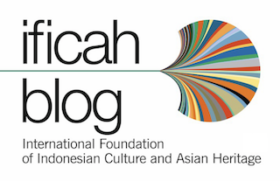To1
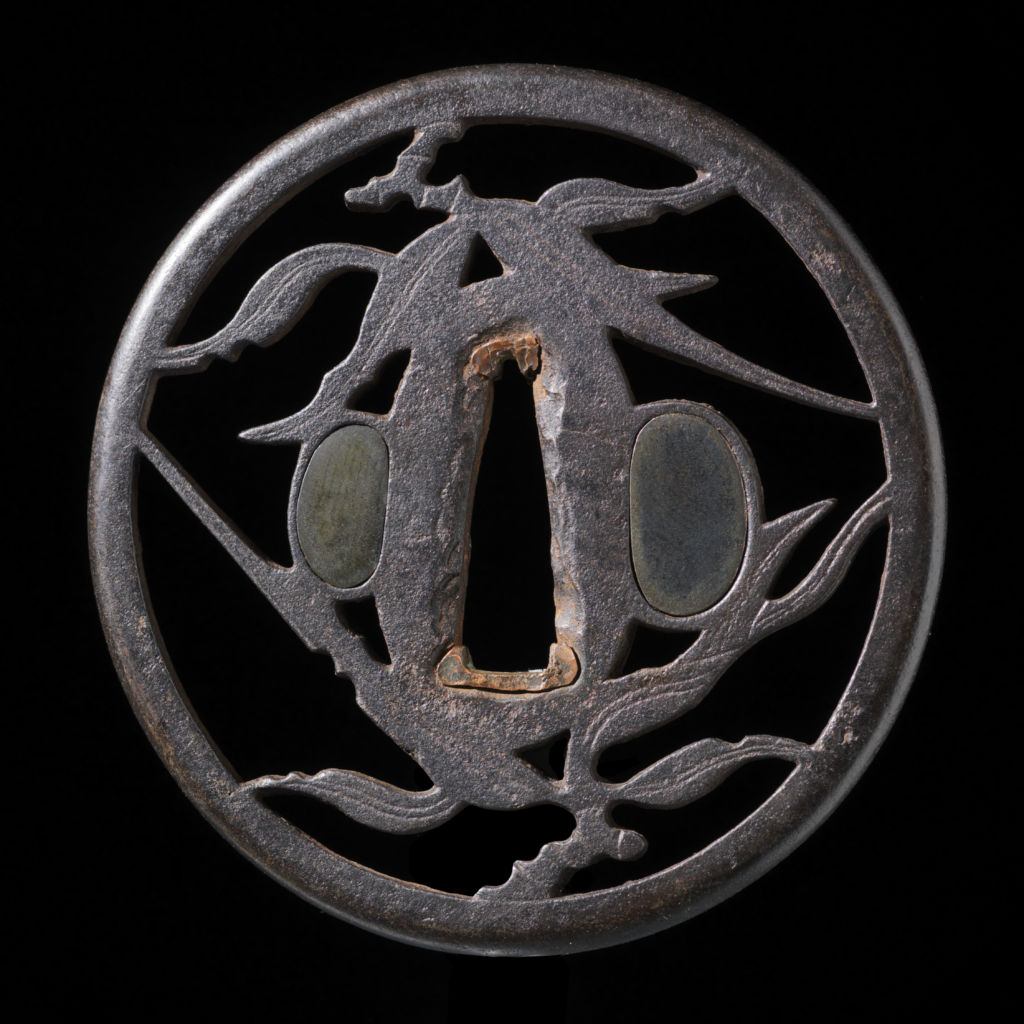
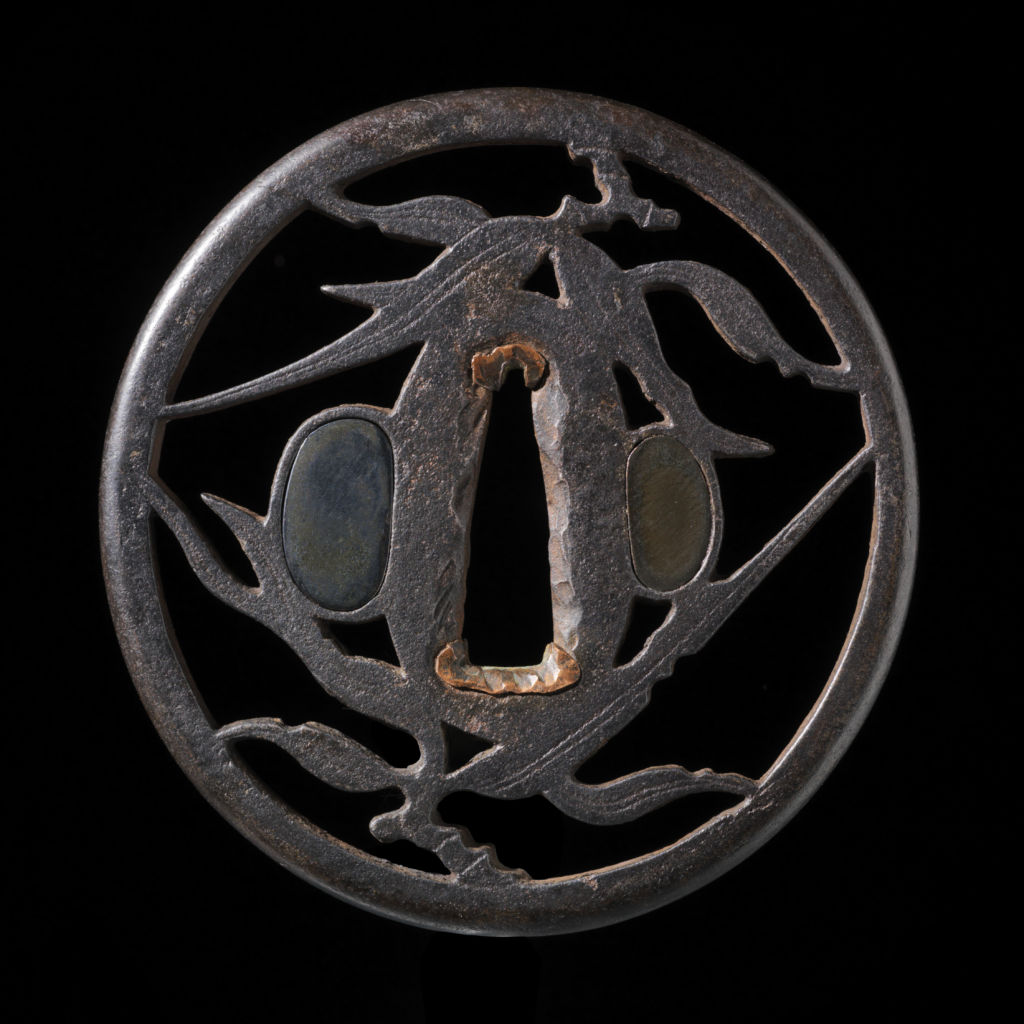
Style: Sukashi
Time period: Muromachi period, ca. 1500
Signature: None
This very fine sukashi tsuba has always been a difficult study piece for me. It is far older than it appears, and must date from the late Muromachi period, ca. 1500. It is very rare for this type of design to be found at that time. So, who would have made such a piece? It would seem this is the work of what we call the pre-, or proto-Akasaka school group. The later Edo period Akasaka school seem to have taken some of their designs from tsuba like this one. What is interesting to note is that this tsuba has far more power and boldness in its design and this did not carry over to the Akasaka school when they borrowed such designs. The Akasaka work was far weaker and more delicate than this type of work. It is a pity that the Akasaka could not produce work as great as this tsuba.
To2
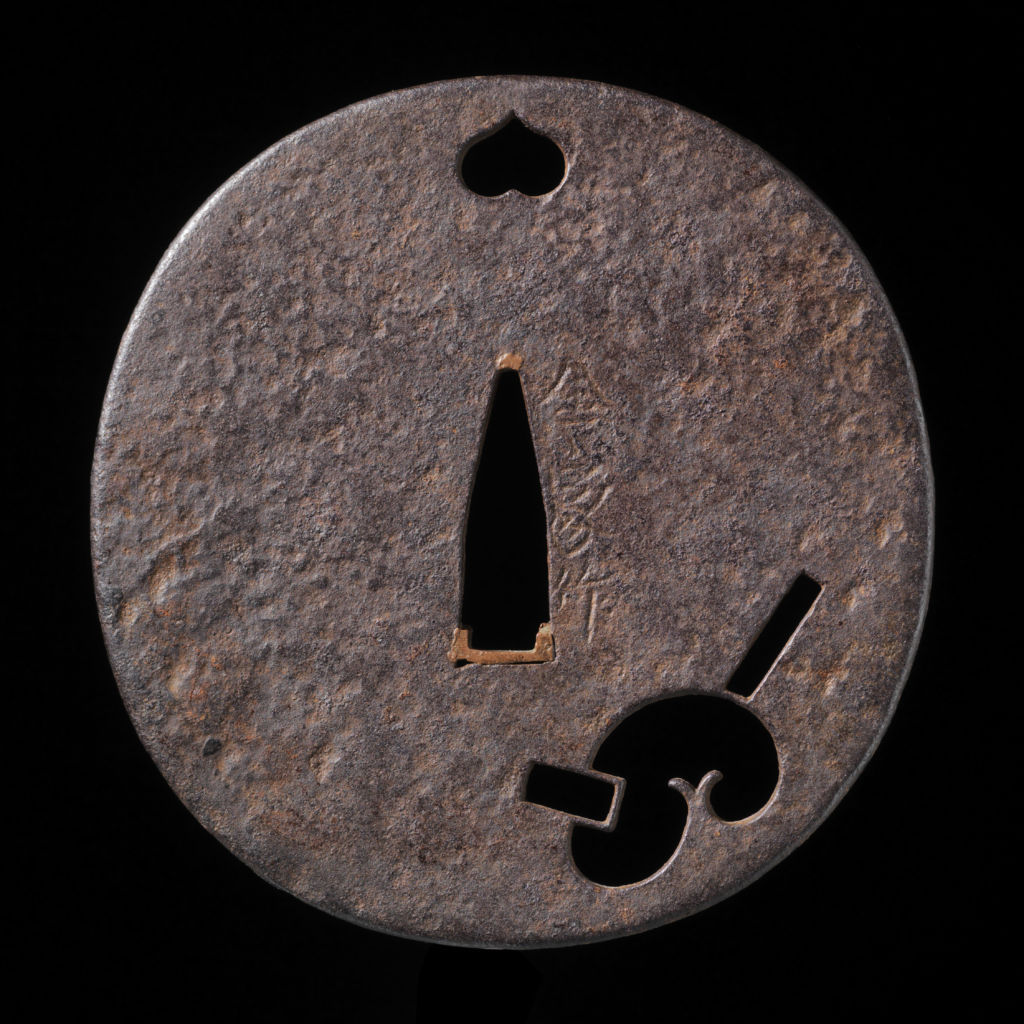
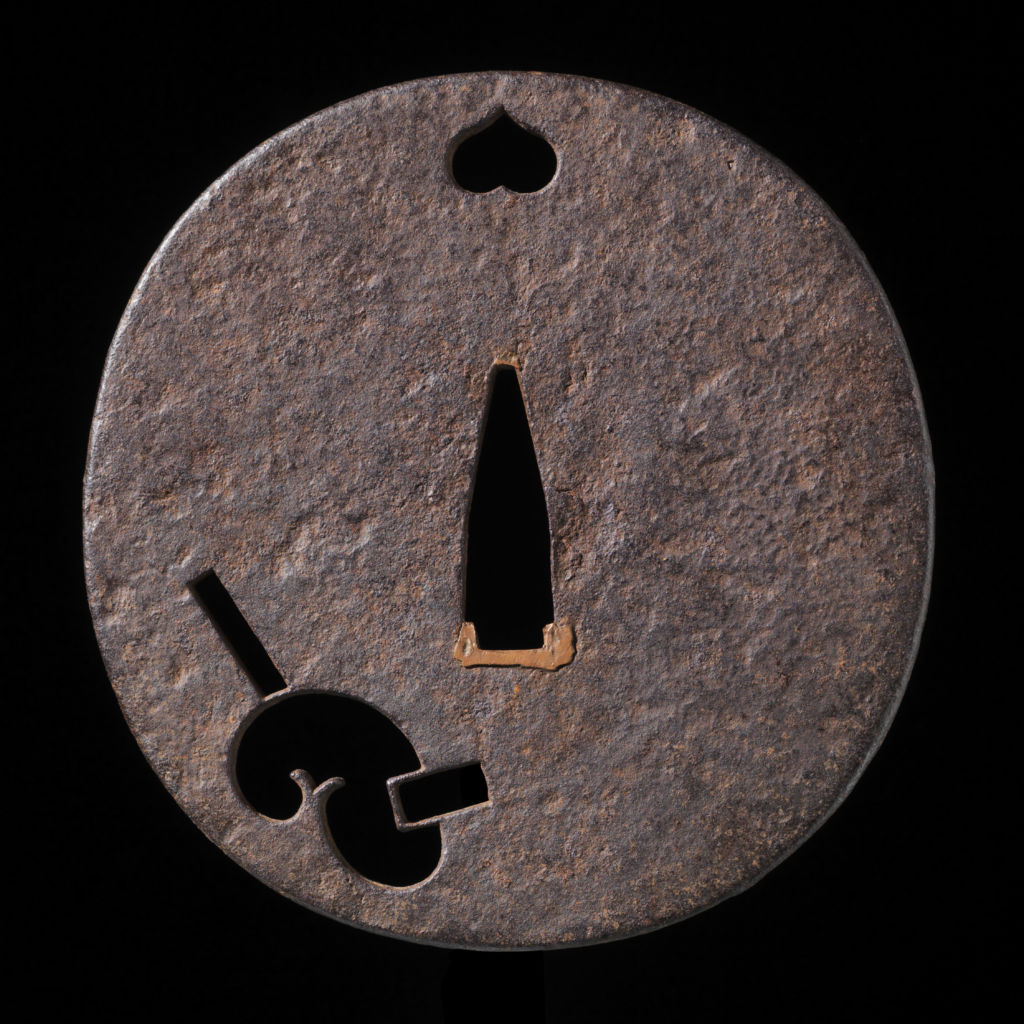
Style: ?
Time period: Edo period, 1700-1750
Signature: Kaneiye saku
This tsuba, and the following two tsuba, are part of the group of important works that are directly related to the Joshu Kaneiye tsuba. In this case of an iron plate in oval from with a single inome opening at the top of the plate and a „gift“ wrap in sukashi at the bottom, right side. The plate is signed on the face, right side of the seppa: Kaneiye saku. This artist is recorded in such books as those by Kawaguchi, Wakayama, and Kokubo, as signing the same way on about eight other examples recorded so far, of which this and the following tsuba are two of the known works. It is interesting to note that no two examples of the work of this artist have common design or workmanship traits, in fact were they not signed we would be unable to ascribe them to this artist. It is my felling that this is one of the „professional“ signers who were employed to sign many of the Kaneiye tsuba, but in the case where he added SAKU after his signature he indicates that these works are mostly his own and were not made in his capacity as official „signer“. Much more research and study will have to be done before we have the full story about this artist.
To3
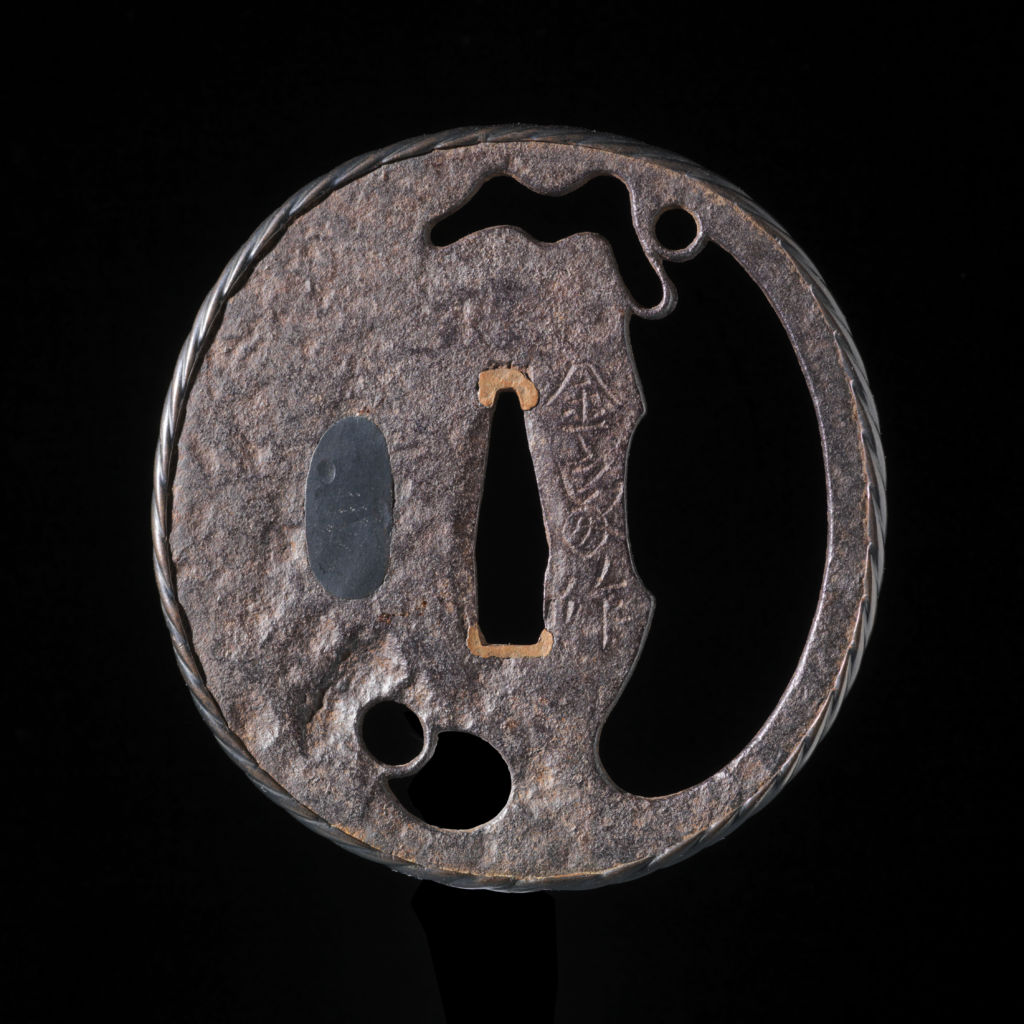
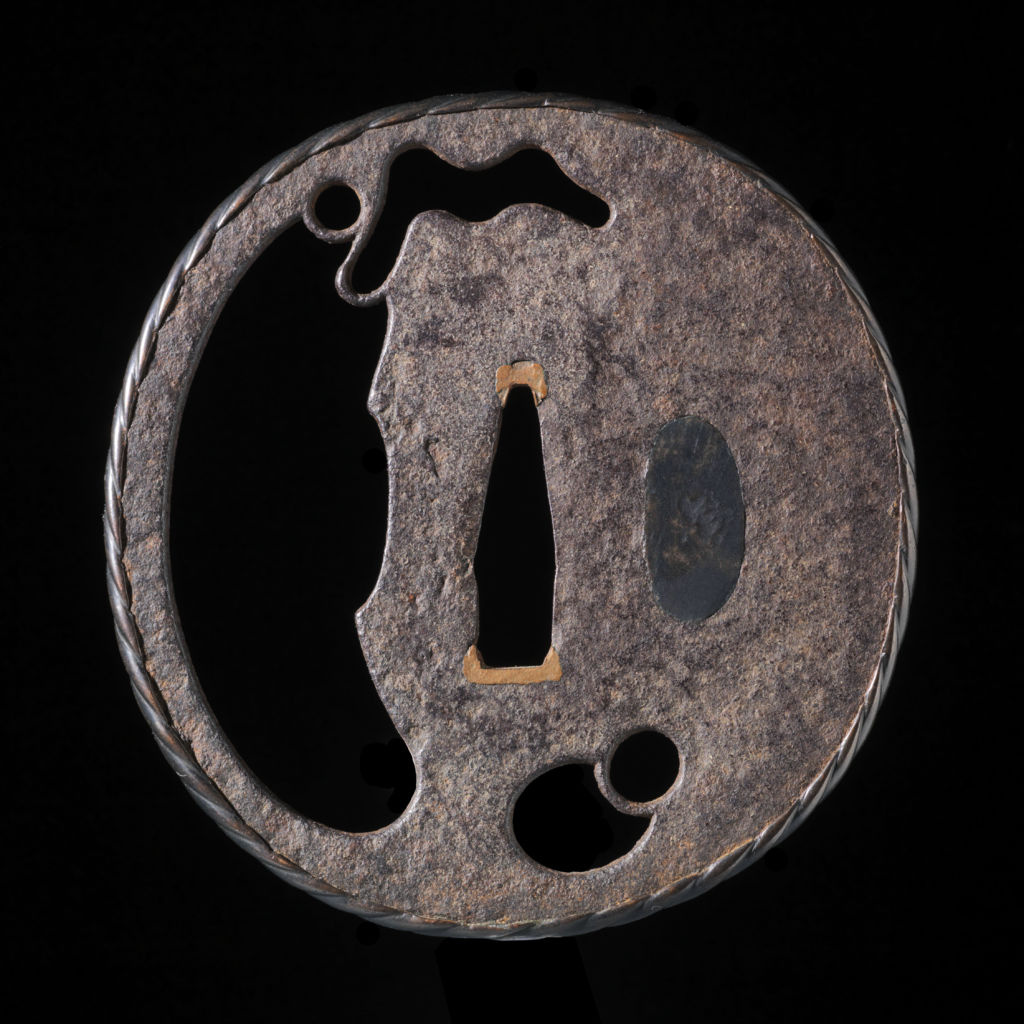
Style: ?
Time period: Edo period, 1700-1750
Signature: Kaneiye saku
This is the second of the two tsuba signed Kaneiye saku. This example is an iron plate of oval shape with a very fine shakudo rope form rim cover. The plate shows very fine hammer work, much in the style of the classical work of the Kaneiye school. The sukashi design is a large gourd with leaf and dew drop, taking up much of the right side of the plate, and a mushroom form at the bottom of the plate. The kozuka hitsu ana is now filled with shakudo plates. Signed on the center right side of the seppa: Kaneiye saku. In the case of this tsuba there is more relationship to the classical Kaneie school tsuba than what can be seen in the first example, but as I said in the first example, there seems to be no relationship in the designs or other factors when he added SAKU after his name. Many may have been made to order so each would be unique.
To4
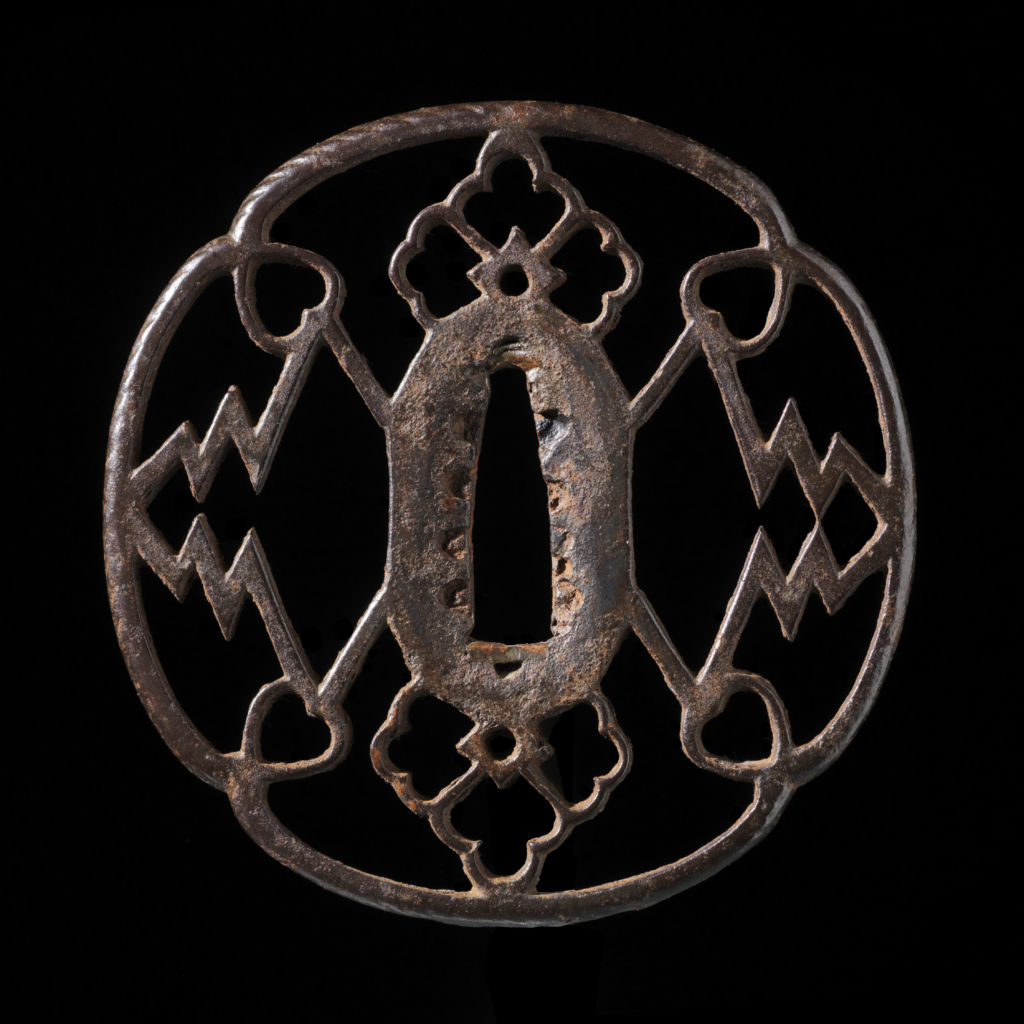

Style: Sukashi
Time period: about 1400
Signature: None
This extraordinary sukashi iron plate tsuba is of mokko form with inome corners, not seen on any other sukashi tsuba recorded to this date. The top and bottom three-quarter flower forms are the karabana, or Chinese flower, and in this form it was used as a mon by the Yoshida family, a branch of the Urabe family, who were, under the Ashikaga Daimyo, very influential in all things pertaining to Shintoism. The side mon are the matsukawabishi mon used by the Ashikaga family. This combination of these two mon indicates that this tsuba was worn by a very high ranking official in the Ashikaga shogunal court in the early Muromachi period. All aspects of this tsuba are unique from its mokko form to the inome corners which are to be seen on tachi tsuba, of soft metal plate, during the early Muromachi period. In addition, the rim is of great interest, for it is partly carved with a rope design, later to be seen on the tsuba of the Takahashi school, and has many very fine iron bones as well. The place of origin, where this tsuba was made, is almost pure conjecture, but with the symmetrical design, the mon subjects and the quality of the work, we can say that the Kyoto area would be the best guess. This is the rarest, earliest, and finest sukashi tsuba so far recorded.
To5
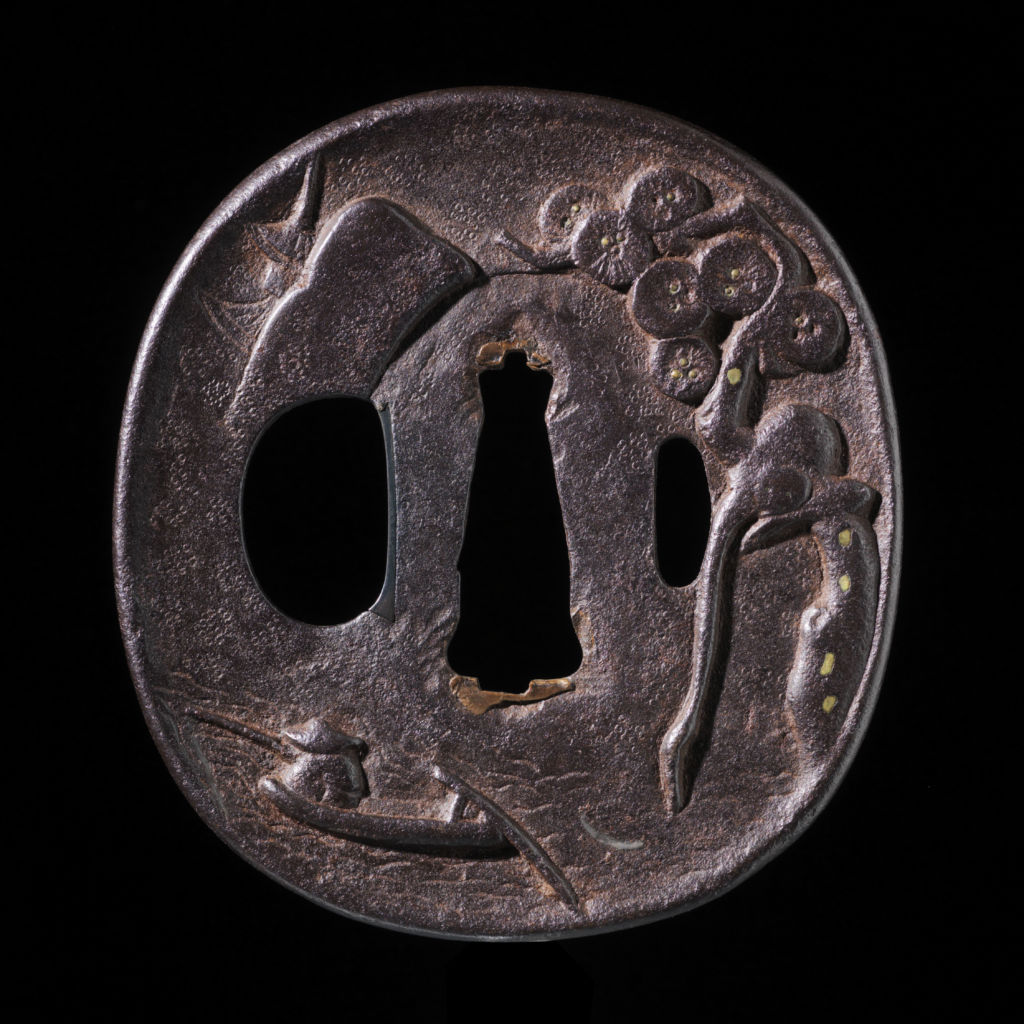
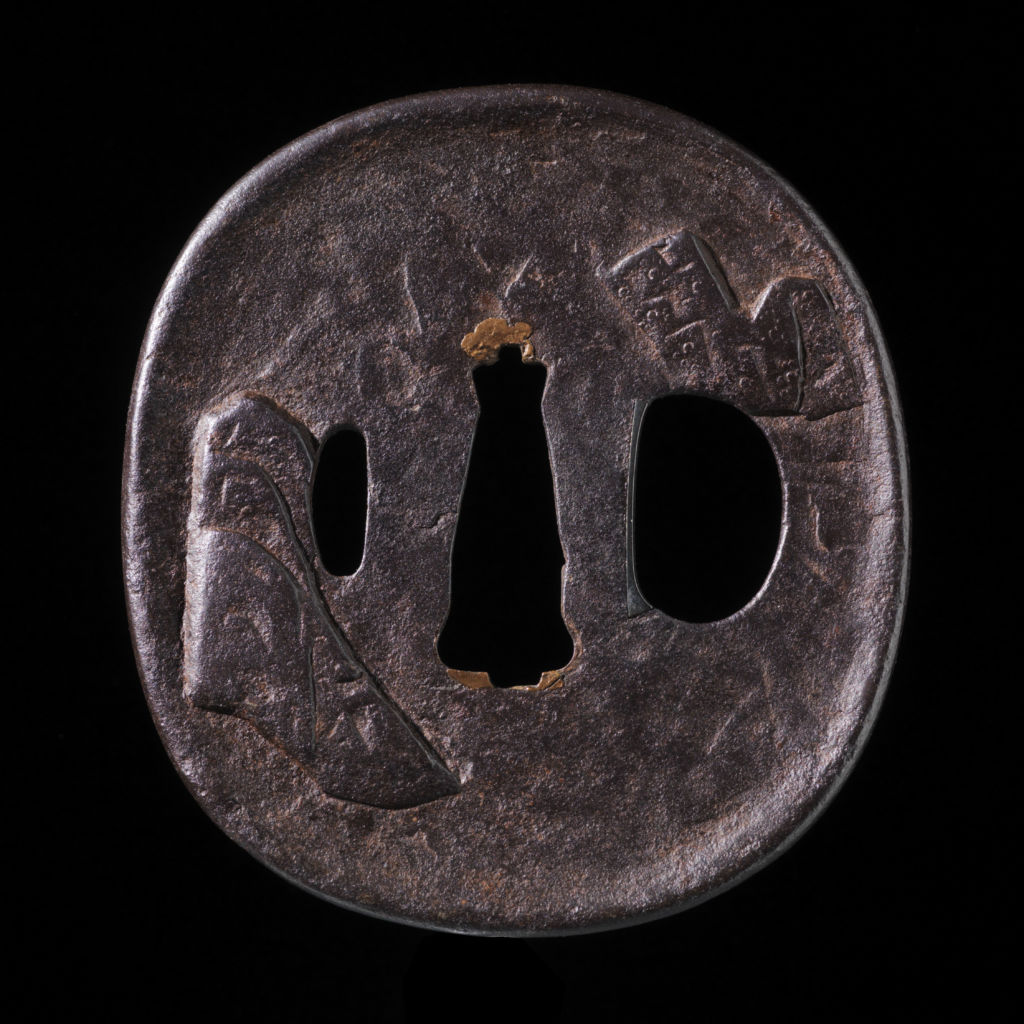
Style: ?
Time period: 15th century
Signature: None
This highly important and unique tsuba is a whole study of the Kaneie school in one piece. The oval iron plate has a very well-formed rim in the classical style of the Kaneie school. The design, which for the most part is iron on iron inlay, consists of many of the design elements seen on a large number of both Joshu and Yamashiro Kaneie tsuba. These deigns are the mountains with the pagoda seen next to it, the pine tree with the long arm monkey trying to reach the reflection of the moon in a stream, a fisherman in a boat on a lake, all these subjects are on the face of this single tsuba. The reverse has two large iron on iron inlay mountains in the Chinese style of the classical Sung period painters. There is some slight inlay of gold and silver on the face of the plate. The small hitsu ana was added later, but the kozuka hitsu ana is original and of the shape seen in many classical Kaneie tsuba. The reason that it is not signed, in my opinion, is that this was made so that the students of the Kaneie school would have a work that they could study to understand how to fashion a classical work of this school. The other important point is that the plate is made of the unique type of iron that we find in the tsuba of the Kaneie school. This tsuba was a gift to me from a very good friend, and now I give it as a gift in return.
To6
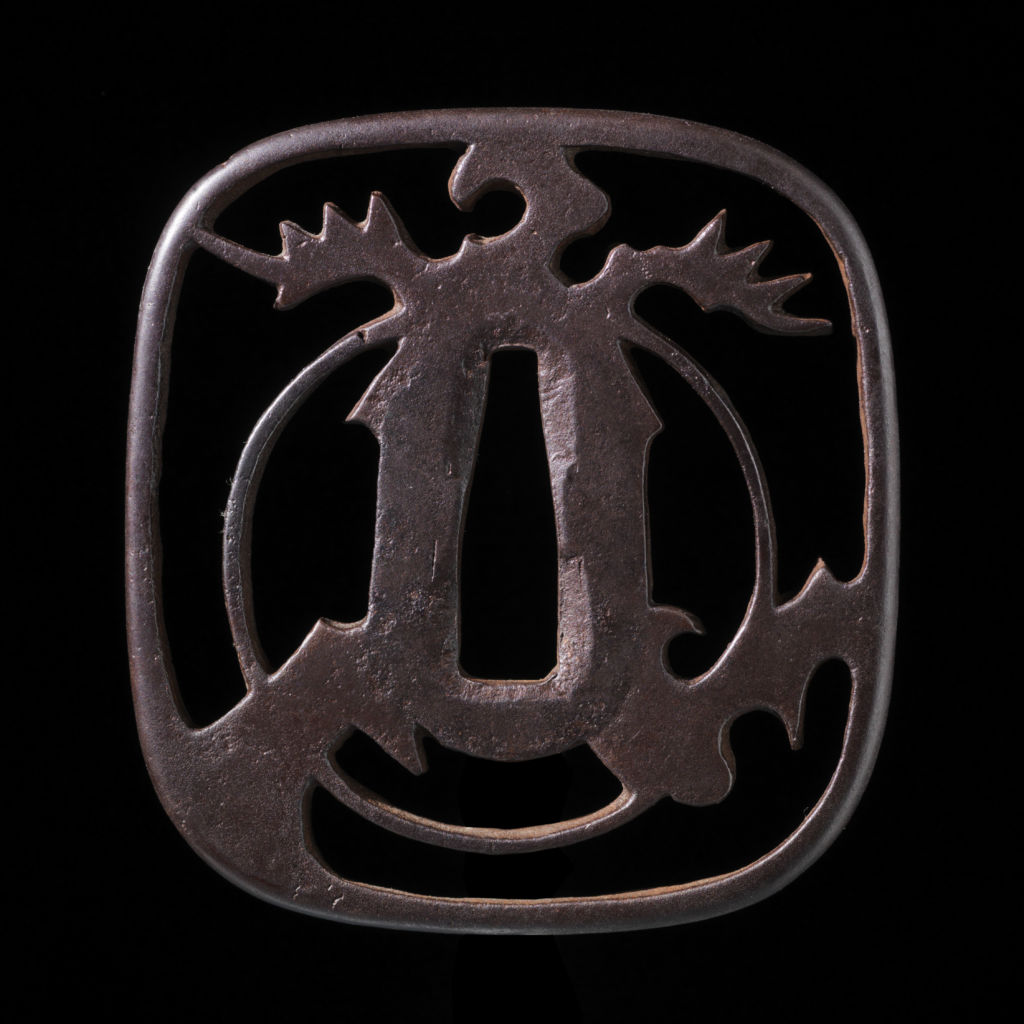

Style: ?
Time period: Edo period, about 1600
Signature: None
This example is what I was talking about when I said that the Akasaka should have produced sukashi tsuba that were bold and powerful. This is a very rare example of the very best of the Akasaka school work when they borrowed the very best from the work of the Muromachi period. Such abstract designs often show this boldness and power I have been mentioning. My guess is: a bird over a sun above waves. Naturally others could have a different interpretation. In any event it is a very fine piece from the early Edo period about 1600.
To7


Style: ?
Time period: 1550 to 1600
Signature: Sesshu Sakai ju Harusada saku
This remarkable tsuba is by an unrecorded master. It is signed: Sesshu Sakai ju Harusada saku. It is very rare to find a tsuba made in the Owari area and signed thus, as Sakai is now part of Owari city. The haru kanji is common to a group of Osaka swordsmiths, see Harukuni,, who might be related to this artist. The very rare thing about this tsuba is its age. One would think that it is mid to late Edo period, but when examined one will see that it is 1550 to 1600 period and that is very rare for the work of a swordsmith. I am glad to now be able to record the name and will continue to try to find out if this is a swordsmith or another artist.
To8
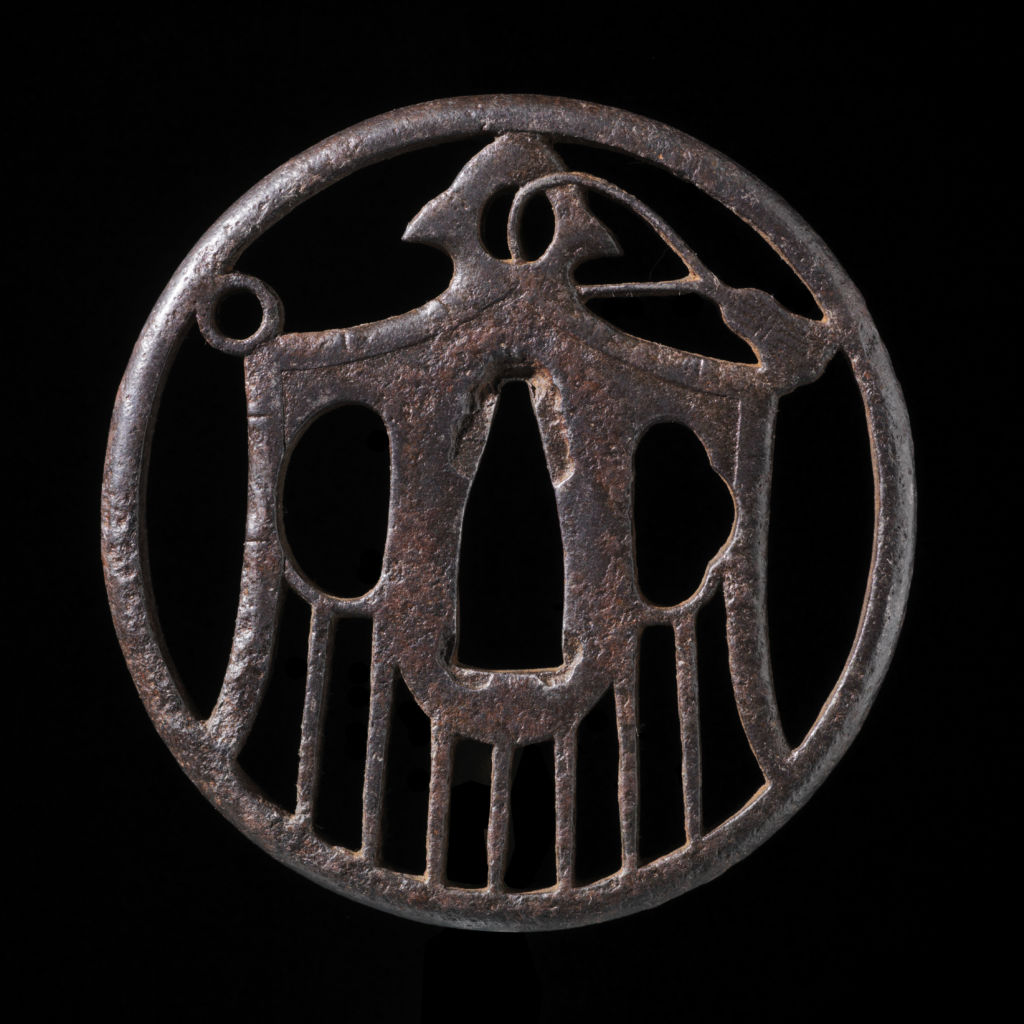
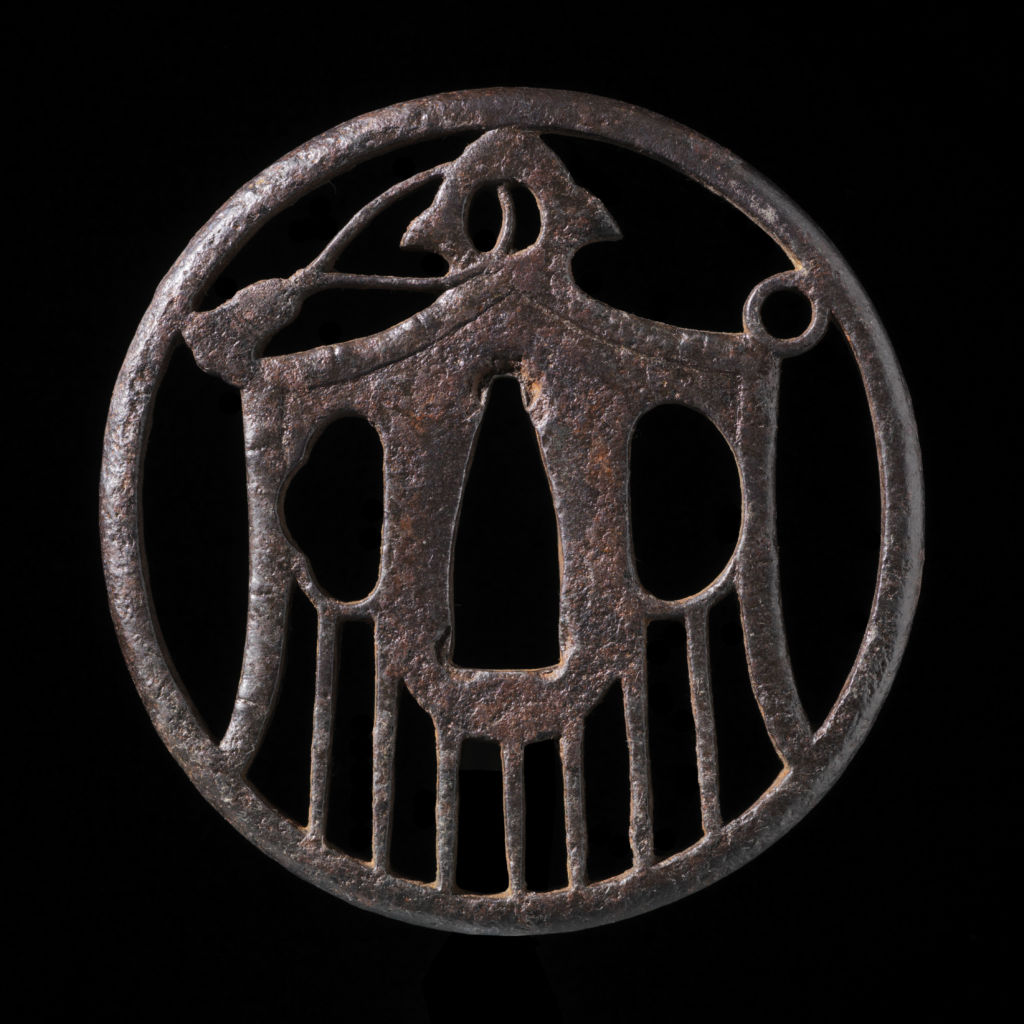
Style: Sukashi
Time period: about early 1500’s to early 1600’s
Signature: None
It is very rare that we know who might have worn a particular tsuba on his sword. The design of this sukashi tsuba is called AKA-TORI. For years this was written with the kanji for red bird. In the early eighteenth century a heraldist discovered that the correct name for this design was aka-tori which means „to take off the grim“. In other words, this is a comb to clean a comb. It is a family crest of the Imagawa and in the family history, Imagawa Norikuni, in a dream, would be victorious in battle if he wore a piece of cloth with the aka-tori design on his helmet, this came to him in accordance with a divine message. This tsuba dates from about early 1500’s to early 1600’s, which is the period of Imagawa Ujizane (1538 to 1614) after his years in battle he became a priest and took the name of Sokan. His family became koke, a title given in the Tokugawa days to a group of great dispossessed daimyo, such as the Takeda, Oda, Imagawa, and about eight more. They were the messengers for the Tokugawa to the Imperial court. They were instituted in 1608. Thus, this tsuba was a part of the history of Japan and was worn by a member of the koke.
To9
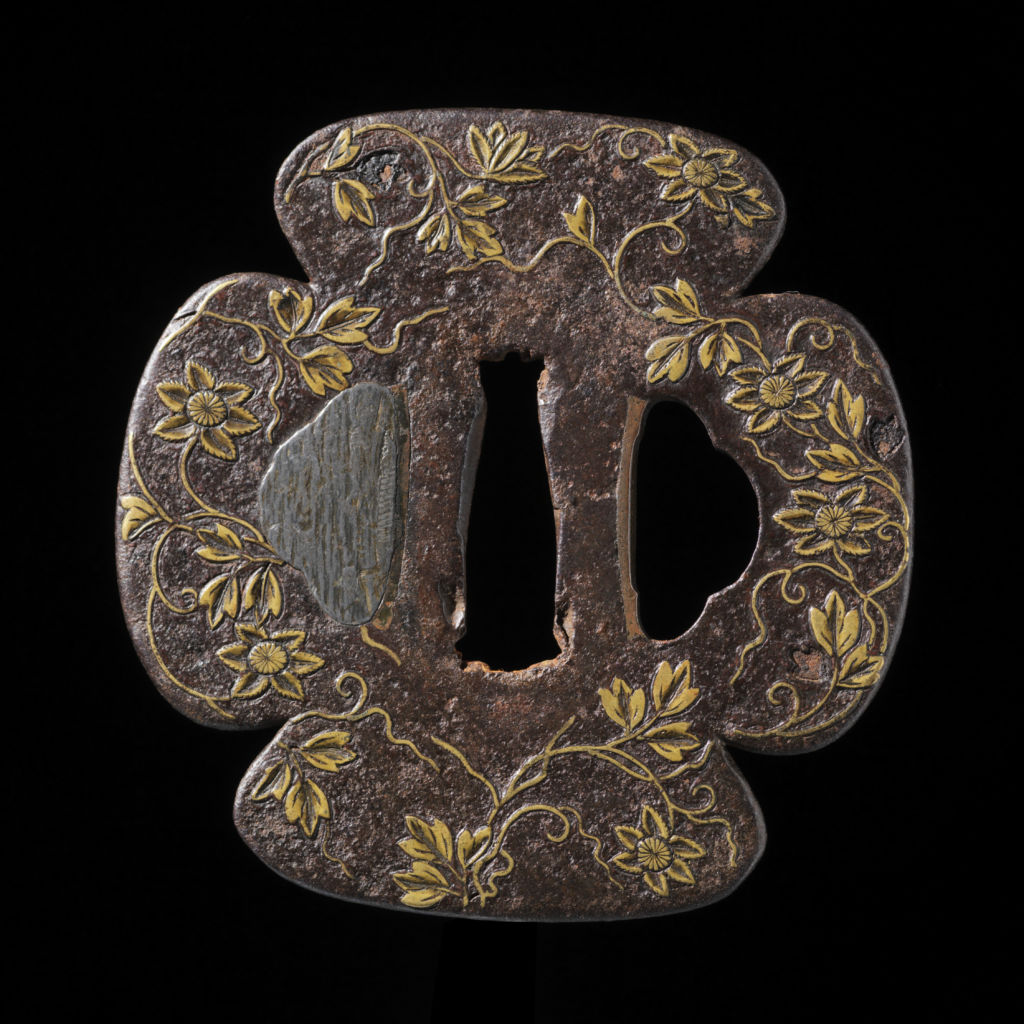
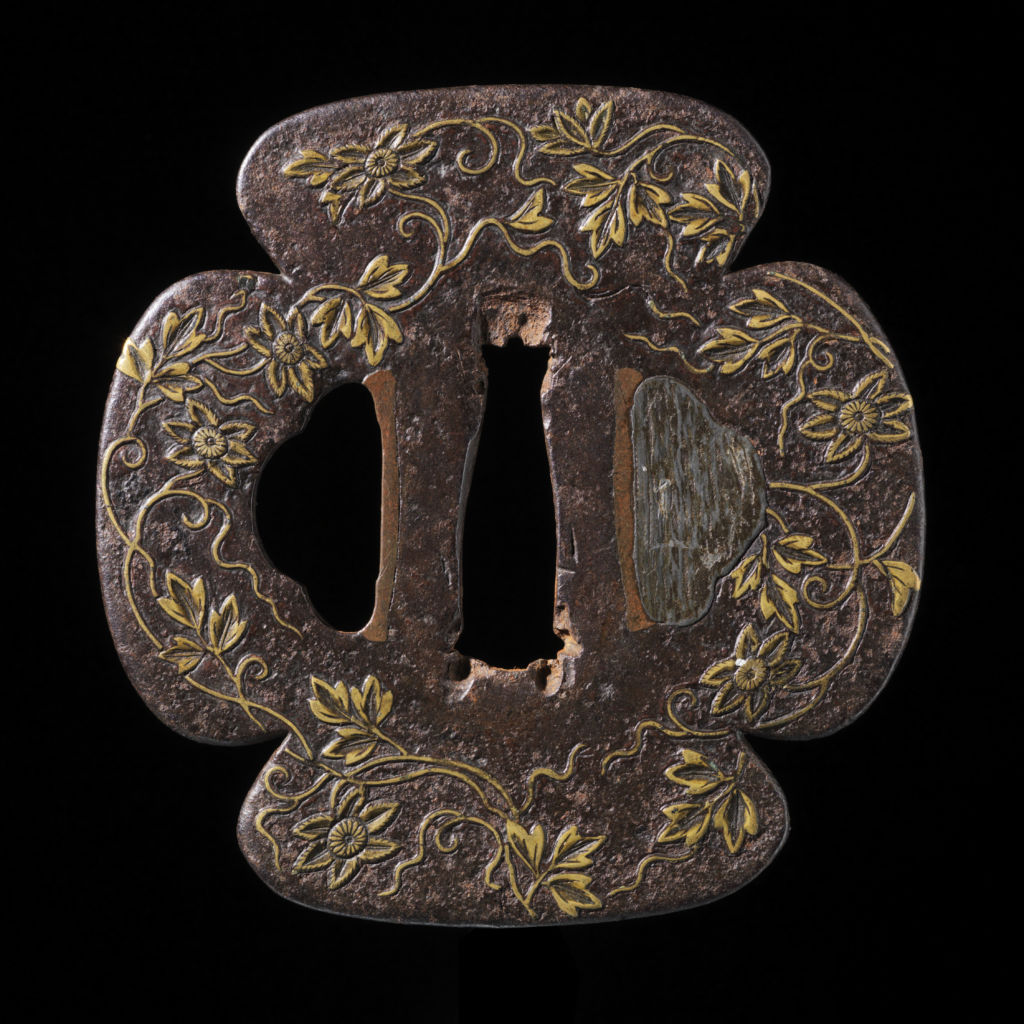
Style: Heianjo-style
Time period: Momoyama period, about 1500
Signature: None
This brass inlay tsuba of the Momoyama period, about 1500, is one of the most sophisticated examples known. It most probably was made in Kyoto for a high official of the Imperial Court, for it shows the elegant design that such a person would have had for his swords mounts. The quality of the inlay of this period was far superior to that of the later periods and such tsuba have far more of the original inlay than later examples. There do not seem to be any signed examples from this period so we can only guess that it was made by someone who worked for those who would have known the artist and thus it was not necessary to sign his work.
T10
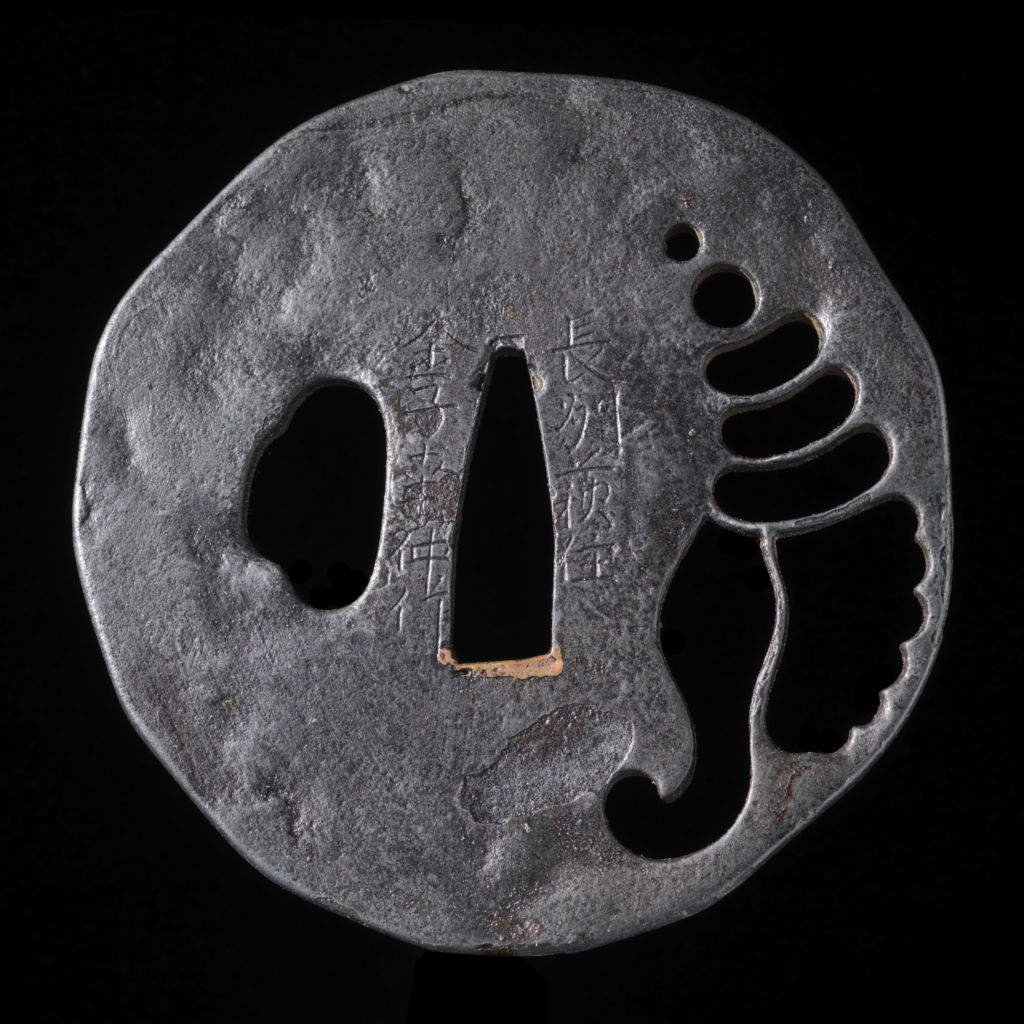
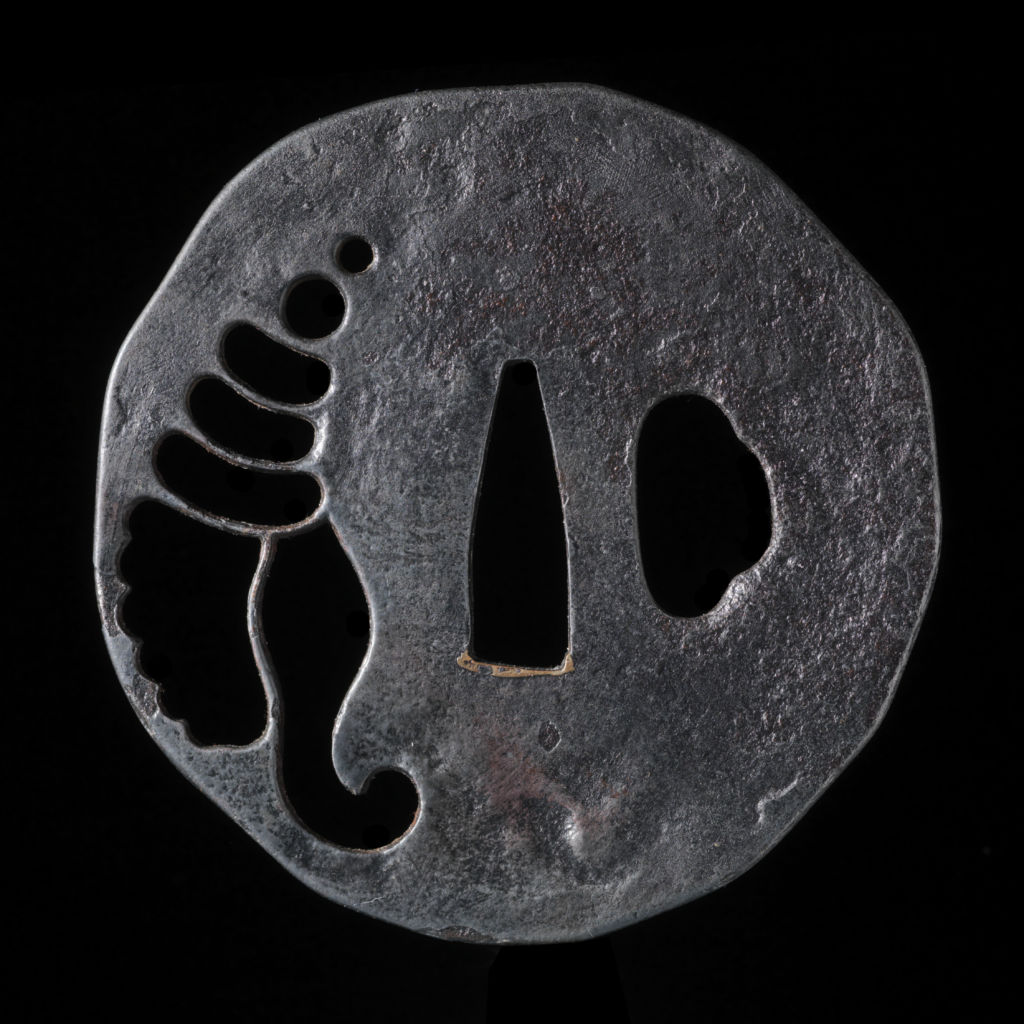
Style: Choshu-style
Time period: about 1650
Signature: Right side: Choshu Hagi ju, left side: Kaneko Yukinaka saku
Iron „fist“ shape plate with a well-formed and hammered surface. The right side of the plate with a large sukashi conch shell covering most of the surface. The large hitsu-ana in the style of those used in the Momoyama period. The right side of the seppa-dai is signed: Choshu Hagi ju, and the left side is signed: Kaneko Yukinaka saku. He was the son of Kaneko Yukishige and is considered the second master of the Kaneko family school. He is said to have worked at about 1700, but this tsuba would seem to be older than that time, and as his father is also listed as working about 1700 these dates would seem to be in error. This tsuba seems to be made at about 1650 and is very important to establish the correct dates for the early masters of the Kaneko family school. Were this tsuba not signed it would be very difficult to determine who might have made it. All of the above are very good reasons why this work is so important as a study piece.
T11
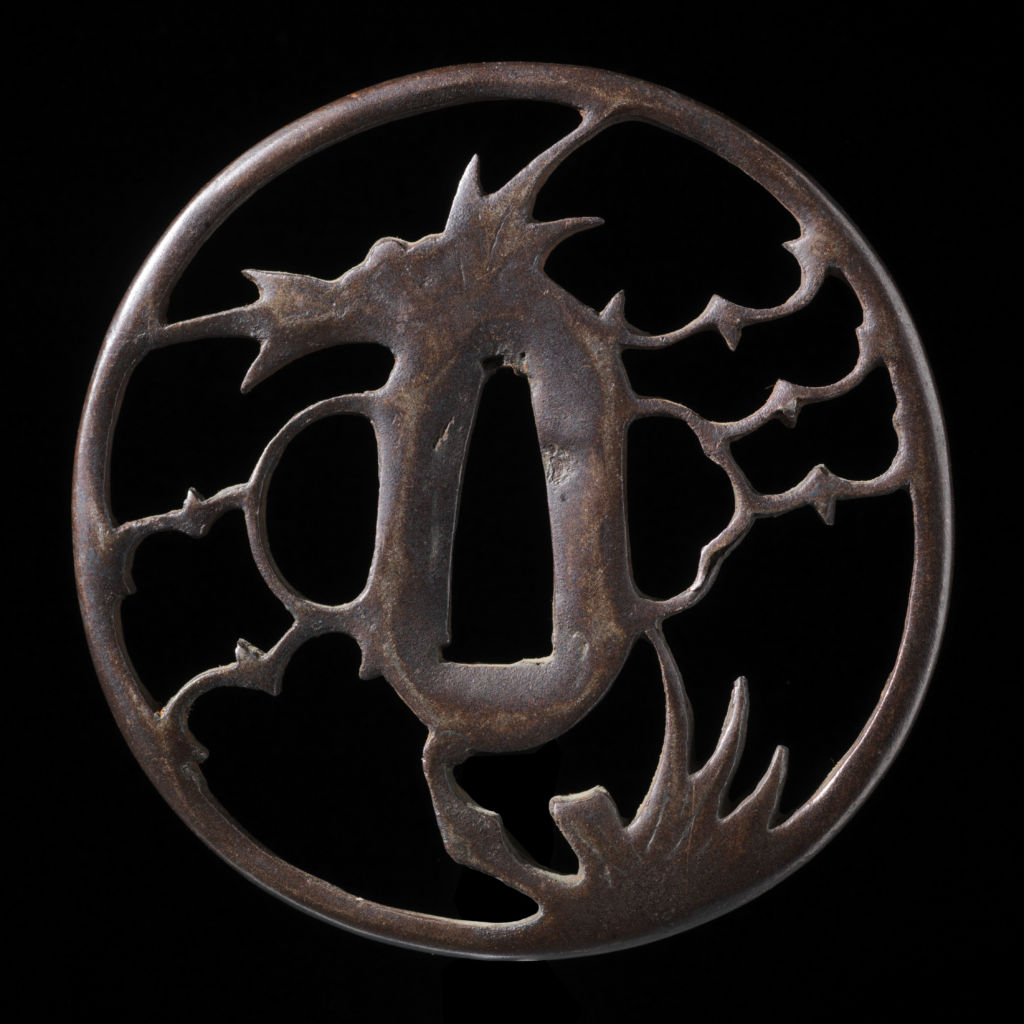
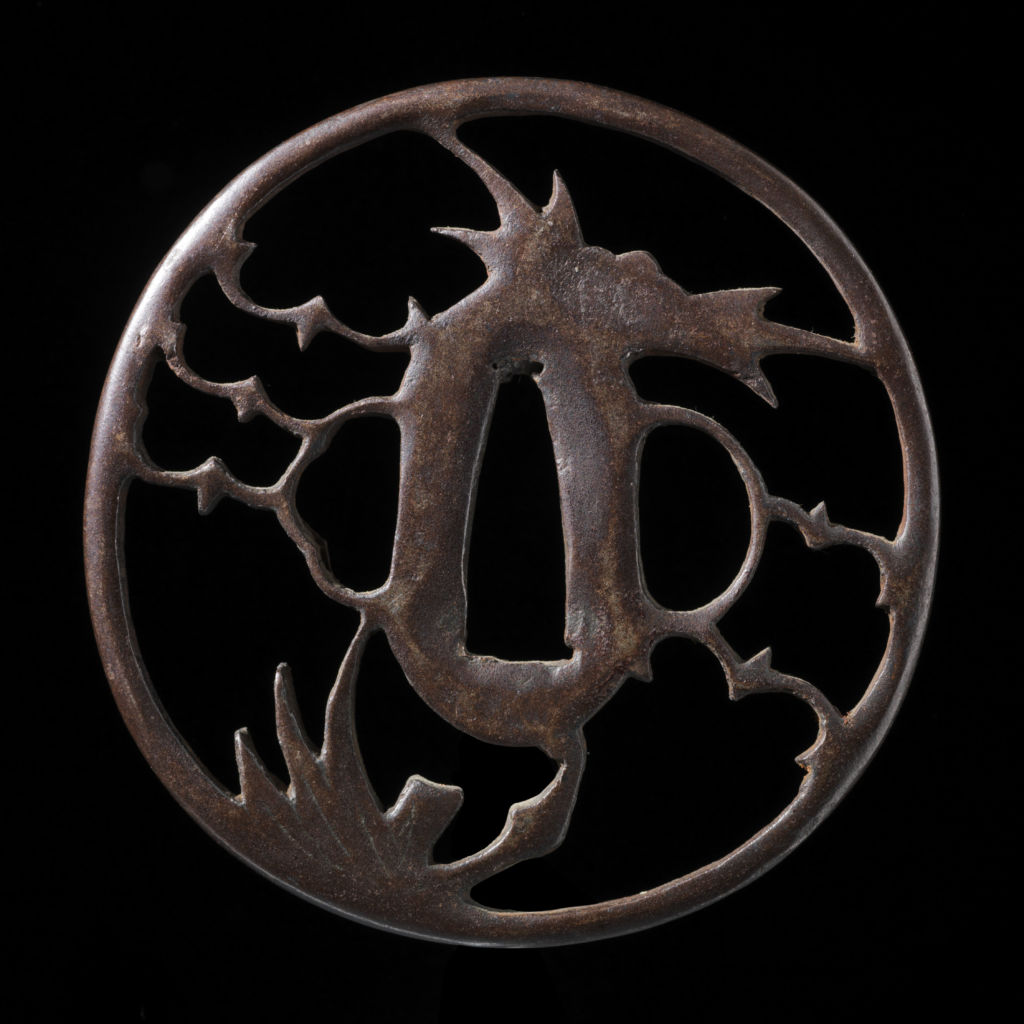
Style: Akasaka-style
Time period: early Muromachi period, circa 1400
Signature: None
The origins of the Akasaka family school are in great debate. There are a number of Akasaka style tsuba illustrated in various books that are presented as KO (old, or pre) Edo period Akasaka school work. Some of them appear to be just that. Akasaka school work produced in the Edo period are well defined and were made in great numbers. The classic designs that were used during this period are often almost delicate and weak in appearance. Which necessitated that the plate be very thick to support the delicate design. Those examples termed Ko-Akasaka are for the most part bolder and much stronger in design than the later work of this school. This example would seem to be the earliest work with what later became a classic „Akasaka“ design. It is of average thickness, but was made with an „S“ fold center plate and thin skin plates on each outer side, giving it a five layer plate. Whereas the Edo period thick plates were three layers, a thick center and outer skin layers on each side. The subject of cloud forms at the top and five flying birds at the center, with grasses at the bottom, is very powerful and well defined. In addition, the rim has many very fine iron bones, something you would not see on any Edo period Akasaka tsuba. If you would examine the walls of the sukashi you will see the great age of this tsuba. It would seem to have been made in the early Muromachi period, circa 1400, thus making this the earliest Akasaka style tsuba recorded so far. A remarkable tsuba in all respects and highly important.
T12
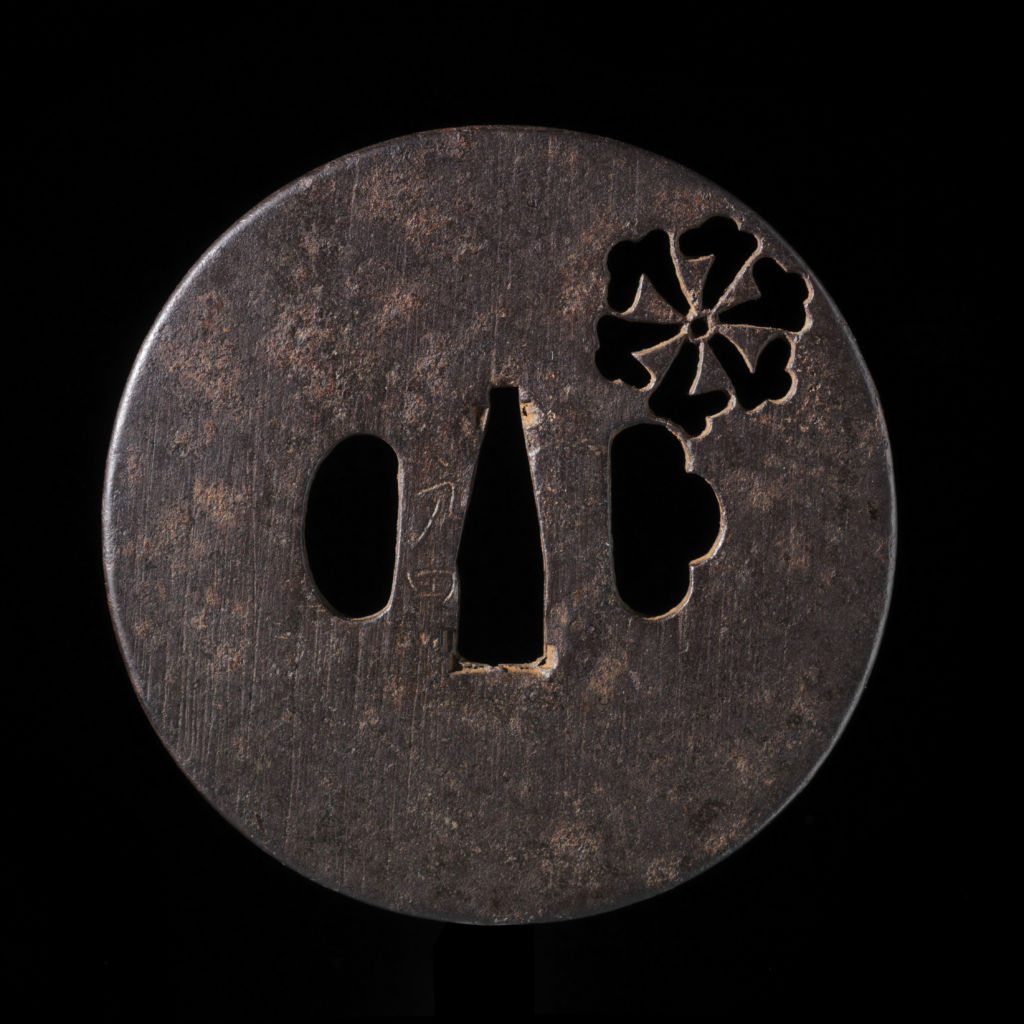
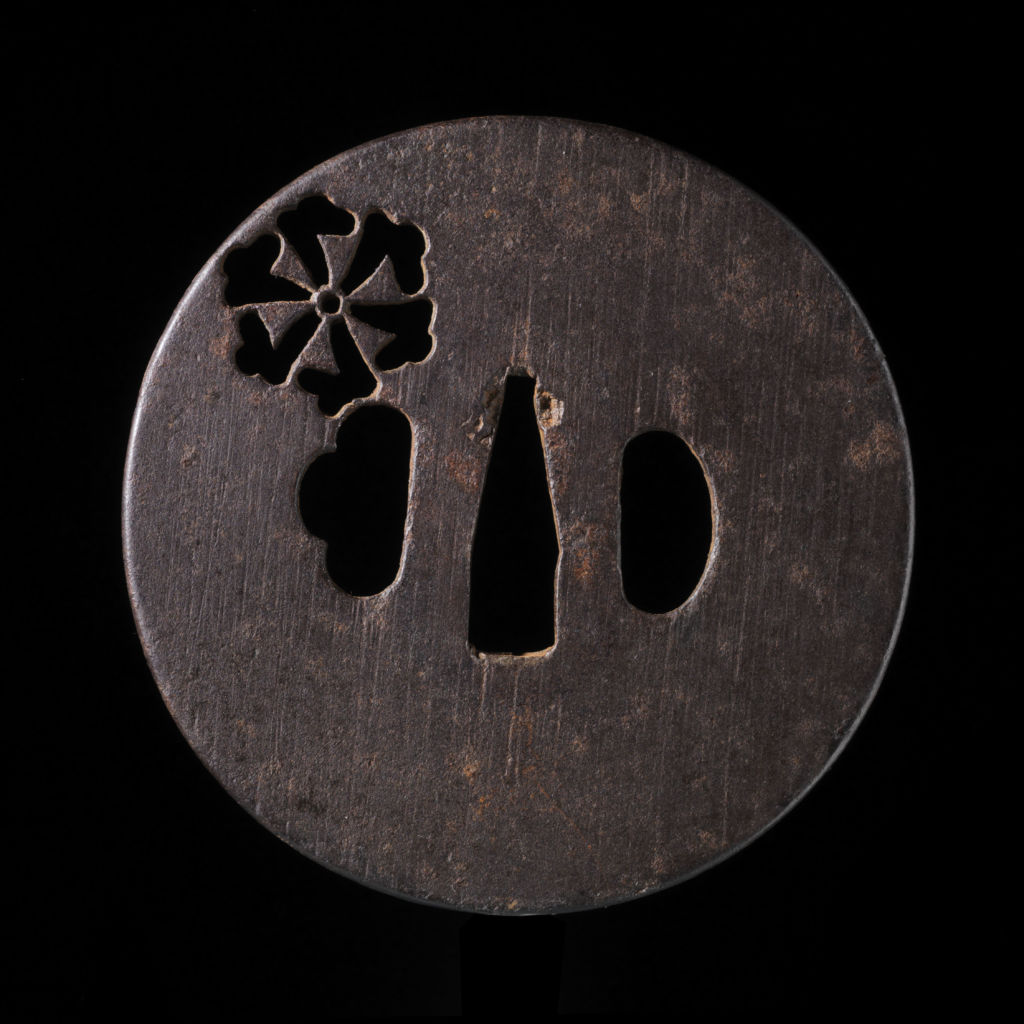
Style: independent artist
Time period: early Edo period
Signature: two kanji that read either, Genda or Moto-da
Round iron plate with the surface carved with fine vertical lines often seen on the work of the Sendai tsuba makers. The sukashi crest is the clove mon used by the Matsudaira family in Sendai. The delicate carving of this mon makes one think this is a late Edo tsuba, but the encrustation on its walls tells us the work is more likely of the early Edo period. The plate is signed with two kanji that read either, Genda or Moto-da. Either reading is of a family name and I have not recorded it as a family or art name. There is also the idea that this is a swordsmith, but Hawley or others has no mention of the name as well.
T13
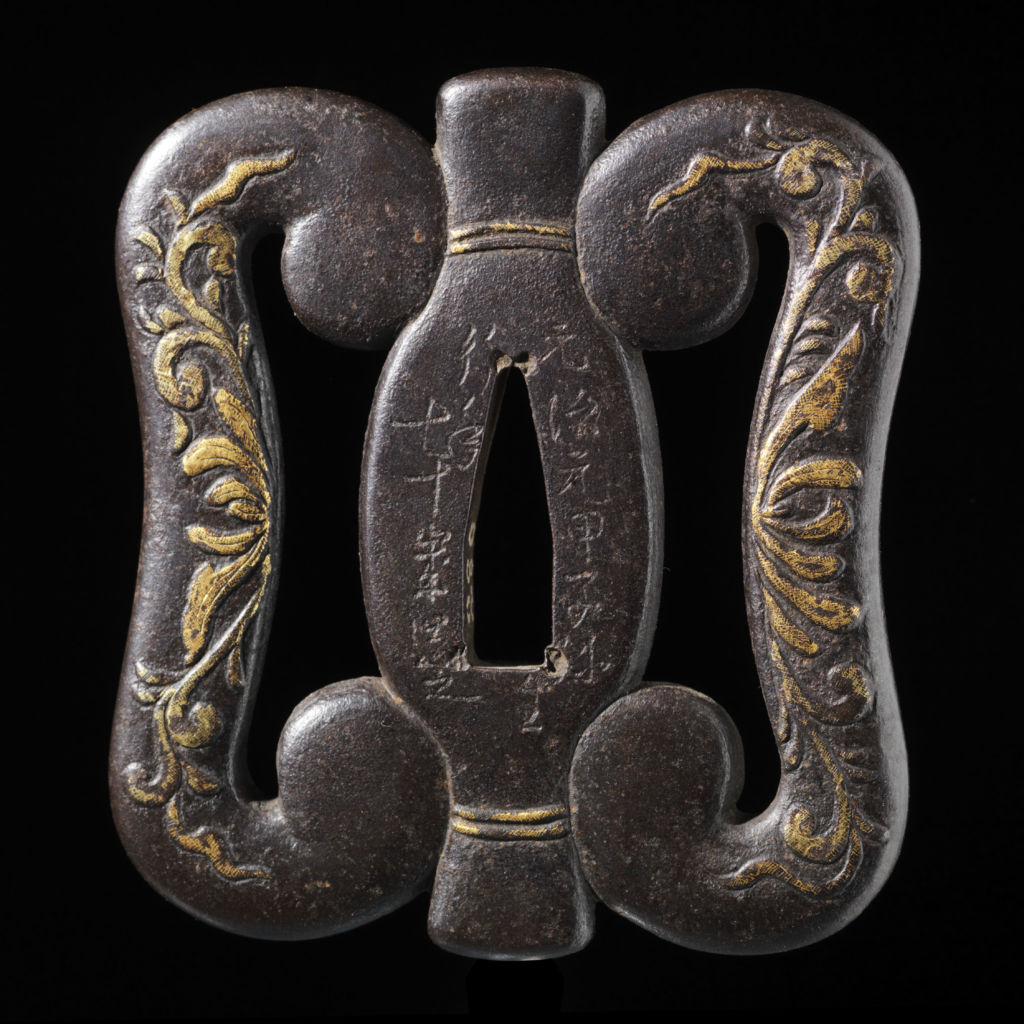
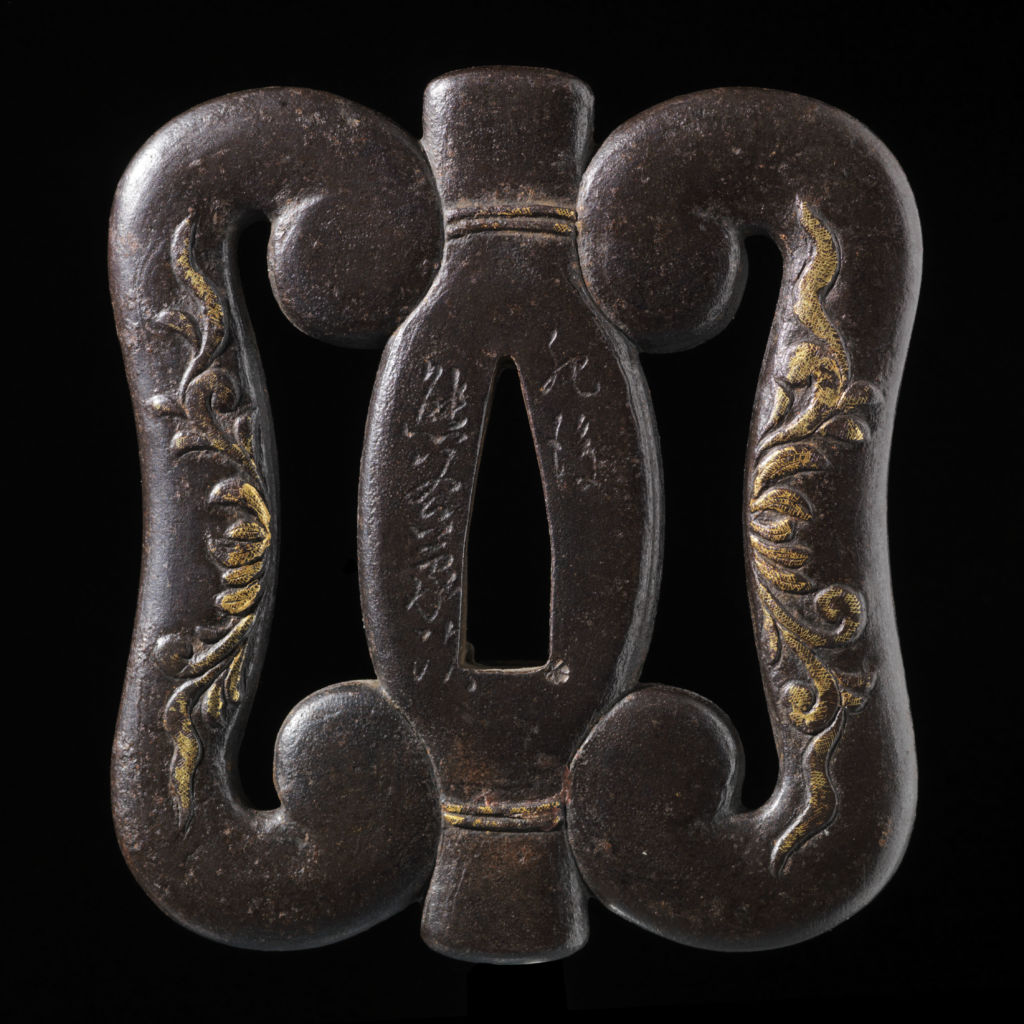
Style: Higo-style
Time period: 1864
Signature: face right side: Genji gen Kei-n nen shozuru, face left side: Kio-nen shichi ju sai tsukuru kore, reverse: Higo, Kumagai Ietsugu
Very large thick iron plate in the shape of a war fan (gunbai), with carved floral scroll work covered with gold nunome, this is repeated on the reverse. Signed on the face, right side: Genji gen Kei-n nen shozuru, and on the left side: Kio-nen shichi ju sai tsukuru kore. This reads: first year of Genji, 1864, I produced this, at the age of 70 years. From this inscription we now know that he was born in 1794. The reverse side is signed: Higo, Kumagai Ietsugu. From an historical point of view, it is interesting to note that 1864 was the year of the Western powers firing on Shimonoseki in Choshu Province. Which probably explains why the war fan was used for the subject of this tsuba. The Kumagai school were retainers of the Hosokawa Daimyo at their large compound in Edo. They made many tsuba and other fittings at the command of their master. In fact, a large part of what we call classical late Higo fittings were made by the Kumagai school in imitation of all the schools and types that were produced at Kumamoto in Higo Province. It is almost impossible to tell which were made in Kumamoto and which were made in Edo. Those made in Edo were used as gifts to other daimyo who also had their compounds in Edo. This very rare tuba is only the second example of his work so far recorded.
